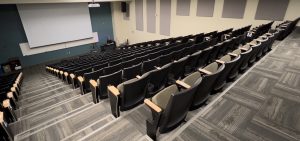Ohio University faculty are happy with enrollment projections, but have concerns
By: Olivia Roman
Posted on:
ATHENS, Ohio (WOUB) – Faculty at Ohio University are thrilled with the expected spike in enrollment this fall, but it also raises some concerns.
“It’s really exciting that so many prospective students want to come to Ohio University,” said Brian Schoen, associate professor and department chair of history.
The university is expecting a possible record freshmen enrollment. This follows years of enrollment declines that have strained the university’s finances. This has some faculty concerned the university isn’t prepared for all those students after cutting faculty and staff levels over the years as it addressed budget issues.
“There is a certain kind of, you know, I told you so quality to what’s going on here,” Associate Professor of English Joseph McLaughlin said. “Enrollments go up and down and we can’t be constantly firing and hiring faculty on a rollercoaster kind of cycle.”
Provost Elizabeth Sayrs responded to this concern with the following statement: “There is always some flexibility in our system, and it’s important to note that, while there were reductions that happened to coincide with the COVID enrollment disruption in 2020-2021, we didn’t decrease faculty to match the very low enrollment level that one year because we knew some enrollment would rebound and our overall planning spans a much longer timeframe.”
Some faculty also feel that bigger classes will affect the dynamic between professors and students. Instructors might rely more on tests over essays in order to adjust to more students in the class, McLaughlin said.
“You just can’t increase the class size infinitely and not have impacts on the way the course is taught,” said Robert Colvin, a professor emeritus of physiology.

She also said that in some cases, course sizes were increased when departments and colleges determined that the course format would allow for effective delivery at an increased size.
Faculty also expressed concerns about the university’s plan for hiring tenure-track faculty, let alone faculty in general.
“We’re concerned because we don’t see any plans yet from the university for hiring tenure-track faculty,” Colvin said.
As enrollment projections increased throughout the spring, the provost’s office worked closely with colleges to start preparing for a larger incoming class, Sayrs said. “We continued to monitor enrollment … adding more sections as well as some more faculty hires as sections filled. The colleges are also already working to plan faculty needs for the next few years to meet the needs of larger incoming classes.”
Sayrs also said it is important to know that the colleges are responsible for submitting faculty position requests to the provost. Student enrollment increases are not evenly distributed, so staffing plans are different for different colleges and departments.
Overall, Sayrs said the university’s “desired enrollment trajectory does include some growth, but the university does not expect continued year-over-year increases at the scale we have seen in this post-pandemic rebound.”

